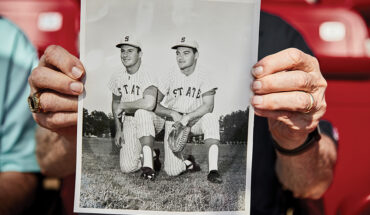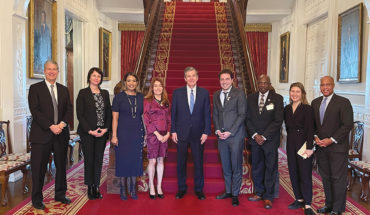by Liza Roberts
photographs by Nick Pironio
William Ivey Long, the prolific, multiple-Tony Award-winning costume designer, has drama – and Raleigh – in his blood, and in every single one of his earliest memories.
“I grew up in the stage left dressing room,” Long says as he gestures around a tiny, WPA-built stone structure that still stands at Raleigh Little Theatre’s outdoor amphitheater. He’s not speaking metaphorically: The dressing room is where he lived until age 3 with his father, a technical director, and mother, an actress who wore many play-making hats. “People would change clothes in our house, and put on costumes … You would open the door, and you’d be on the stage.”
Doors – and stages – have a way of opening up for Long. On Broadway and London’s West End, he has showcased his talent for almost 40 years. He has 15 Tony nominations and six Tony Awards, and has designed costumes for more than 70 Broadway productions. He has received the Art Institute of Chicago’s “Legend of Fashion” award and was inducted into the American Theater Hall of Fame. He has the Order of the Long Leaf Pine, the City of Raleigh Medal of Arts Award, and the North Carolina Award in Fine Arts. Costumes for the likes of the Metropolitan Opera, Mick Jagger, the New York City Ballet, and Siegfried and Roy round out his resume.

Vanessa Redgrave wears a Long-designed costume as Queen Elizabeth I in The Lost Colony; photo courtesy of Aaron Trotman
But despite his starry spot in the Broadway pantheon, manifested by his current role as head of the American Theatre Wing (the organization that runs the Tony Awards), Long remains resolutely North Carolinian, a natty Southern gentleman with gracious manners, good humor, and stories to tell. He’s as likely to digress about his large extended family (and their furniture) as he is to talk about his life of glamour. And he has remained loyal to the theaters here that launched him: This summer will be his 45th working on The Lost Colony play in Manteo.
Growing up in the South has informed “every one of my sensibilities,” Long says. “How I was raised, telling stories, being in North Carolina, which is, I think, a very diverse culture … the abundance of educated, cultivated people … Revering the word, growing up in a family where the play is the thing …”
Long’s words meander happily as he recalls his early influences: old Western movies; the Raleigh Rose Garden; the Long ancestors who were members of the first class at UNC-Chapel Hill in 1795; the actor Andy Griffith; Long’s great-grandmother’s sister; The Lost Colony costume designer Irene Smart Rains; the playwright Wendy Wasserstein; his parents.
“I’ve always been interested in the making of theater, because of being right here.” He takes in the dressing room with a glance. “The business of our family was always play-making.”
Destined, not designed
Considered by critics a nimble designer whose work marries storytelling and glamour – together with an unmistakably sexy jolt that “hovers between taste and travesty,” as famed New York magazine theater critic John Simon put it – Long is also considered technically ingenious, with a specialty in “transformations,” costumes that seamlessly turn a scullery maid into a princess, for instance, or a greasy car mechanic into a rock star.

The Frogs, Dress Rehearsal, Lincoln Center Theater, June 19, 2004, Credit Photo ©Paul Kolnik, NYC 212.362.7778

Long’s crimson feather ballgown that morphed into a living Christmas tree in La Cage aux Folles; @CarolRosegg
“I love transformations,” he says. “I love transforming people.” At the same time, he says, his main goal is always to help tell the story. “I like to think that I’m an honest and true designer who supports the material.” Michael Feingold, theater critic for the Village Voice, agrees. Long deploys “a kind of secret, supplemental playwriting,” he wrote, “done not to compete with the script being performed, but to enhance it … William is one of the master dramatists of our day.”
Long’s ethereal, transformational costumes for Cinderella, which won him the 2013 Tony; his over-the-top looks for Hairspray, which won in 2003; and his canny creations in last year’s On the Twentieth Century, which nabbed a nomination, showcase a portion of his talent.
“His costumes look more than designed – they seem destined,” says critic Simon.
Destined, not designed might be an apt description of Long’s career as well. He never set out to design costumes, he says; never gave them much thought at all. His interests were more varied. He took himself to William & Mary for college, for instance, because he loved the campus architecture and wanted to study art history. Then he took himself to Yale School of Drama because he wanted to be a set designer. He moved himself to the Chelsea Hotel in New York because he wanted to work for the couturier Charles James, who lived there. (It took Long six months to get James’s attention; in the meantime, neighbors like Andy Warhol “superstar” Viva and a punk-rocker called “Neon Leon” kept things interesting.) Long only became a Broadway costume designer, he says, after a friend from Yale was hired as the set designer for The Inspector General in 1978 and recommended Long to do the costumes. One production led to another, and “it slipped up on me,” he says. “It wasn’t conscious. It was so omnipresent that it became a self-fulfilling prophecy.” Long had become a costume designer.
That was 38 years ago. “I am much more focused now and fierce – fearsome – in my approach than I was then,” he says. “I was young and naïve.” His first Tony, for Nine, focused his mind and gave him bigger dreams. “It didn’t just overnight change my life, but it did inside.”
Of a piece
Wherever his profession takes him, Long is never far from home. It’s not only on his itinerary year-round, it’s also readily in his thoughts, forming his frame of reference. Home and theater were and are of a piece.
“The front hall of our big house in Rock Hill was always a scene dock,” he recalls. (His father, William Ivey Long Sr., was founder of the theater department, stage director, and professor at Winthrop University in Rock Hill, S.C.) “And the big dining room table, which I finally restored, my grandfather’s dining room table from Baltimore, it was always the cutting table during shows. I think twice in my life, my father did The Heiress. Well, the entire house was emptied on to that stage. It’s set in 1840, so all of the portraits, all of the furniture … routinely, pieces of furniture would go missing and be on stage.”
Trim in the navy Brooks Brothers suit and polished loafers that serve as his uniform, curly hair askew, it’s not hard to picture Long as a younger man; his bearing and energy alone take decades off of his almost-69 years. “If you don’t look in a mirror,” he says, “you don’t know how old you are. I stand in front of mirrors all the day long for the fitting process, and I do not look.”
He always wears a rep tie, he says, and almost always one with a blue stripe. For someone in his line of work, this conservative lack of ostentation is striking. It suits him to be as polite in his clothes as he is in his manner, even as it adds an extra wink to his conspiratorial smiles.

The stage left dressing room at Raleigh Little Theatre where Long lived with his parents, Mary Wood Long and William Ivey Long
Vanity Fair zeroed in on this ineffably put-together quality last year when it put him on its international best-dressed list. Alongside the likes of Prince Harry in a top hat and Eddie Redmayne in Gucci plaid, Long appeared in his Brooks Brothers suit and shoes, accessorized only with a grin and glinting eyeglasses. But he’s nonplussed by all of that; doesn’t bring it up unless asked, and then changes the subject.
Ask him what does excite him most these days, and he might tip over his chair with glee. “I’m charting new courses,” he says, with several projects in the works, including costumes for the new weekly television variety show by Lorne Michaels, Maya & Marty. It’s not Long’s first foray into live TV, for which his background in theater is well-suited. He also designed costumes for Grease: Live, as well as the TV version of The Rocky Horror Picture Show for the Fox network.
“All three things are different. Now I can say I design for stage, screen, and television.”
New things excite him most, he says, and always have. “When I was in the 8th grade,” he recalls, “in Mrs. White’s biology class, she asked: ‘Why does a bug go from one side of the leaf to the other? It’s in search of the heat.’ And I knew then and there in the 8th grade that that was my path in life. I was going to be in search of the heat. That’s how I choose my course. That’s how I choose my friends. That’s how I do everything. I’m a bug on a leaf in search of the heat.”
Early years
Just like that 8th grade revelation, much of what fires Long’s imagination got to him early. Summers spent in Manteo, working with his family to help put on The Lost Colony, where his father was technical director, were an important early experience, not only for the time he had on stage beginning at 8 in the role of a child colonist, or for his time soaking up the work of the costume shop (the Elizabethan ruff he made for his dog out of a scrap of pillowcase when he was 4 is hard to forget), but for the late-night movies he’d watch once the family got home from the evening Lost Colony performance at around 11 p.m.
“The black-and-white late movies on the Norfolk station were Hollywood musicals, Hollywood Greta Garbo films. That began my fascination with glamour … and influenced my sense of shape, and style, and proportion.”

Long and Raleigh mayor Nancy McFarlane take a selfie in front of the plaque commemorating his childhood years at Raleigh Little Theatre
During the winter, he’d watch Picture for a Sunday Afternoon: “Our family did not watch football.” He credits his great-uncle in Waynesville for taking him to the movies on Saturdays, where they saw Gene Autry and Tom Mix Westerns. “It was high style in the Old West. And it’s a next step to Gary Cooper in Morocco. The most glamorous, handsome, stylish American in the history of America. Gary Cooper and Marlene Dietrich in Morocco: If you want to mess up a child, have them watch that late at night.”
And give him a homeplace out of a fairy tale. Long leans almost entirely off of his chair as he describes his first three years living in the dressing room where he sits. The one-room building is almost impossible to imagine as a home – but in Long’s memory, it’s fully that. “There were two mahogany Chippendale chairs and a tilt-top table,” he says, “even in this little manger.” Red draperies: “brocade, or velvet. I remember red. I don’t remember bathing, or going to the bathroom, or cooking, or eating … but I remember playing on that stage.”
He also remembers playing in the Raleigh Rose Garden (“I thought everyone had one”); remembers “sitting on a bench in the dark” and watching a “strange man pulling my mother’s hair.” Turns out she was onstage just outside their tiny home, acting in Death of a Salesman.
On that same stage on a sultry evening in mid-May, dozens of notable Raleighites gathered to honor Long. Raleigh Mayor Nancy McFarlane introduced him as “one of our prominent native sons” and unveiled a plaque on the house to commemorate his childhood years in the place.
“My oh my, not everybody gets to see their tombstone!” Long exclaimed. Governor Jim Hunt (“my hero,” Long calls him) and his wife Carolyn came to pay tribute, as did former News & Observer publisher Frank Daniels Jr. and his wife Julia, along with dozens of other art patrons and theater lovers. Long greeted them all with kisses and hugs, taking in their congratulations with humble humor.
“The lesson to take home for your children and grandchildren,” he told the crowd, “is be careful where you grow up!”











